influence of Chinese entrepreneurial companies’internationalization on independent innovation:Input incentive effect and efficiency improvement effect
2017-11-01XinXuYunXiaChuntaoLi
Xin Xu,Yun Xia,Chuntao Li
aSchool of Accounting and Finance,Zhongnan University of Economics and Law,China
bSchool of International Business,Jinan University,China
cSchool of Finance,Zhongnan University of Economics and Law,China
influence of Chinese entrepreneurial companies’internationalization on independent innovation:Input incentive effect and efficiency improvement effect
Xin Xua,*,Yun Xiab,Chuntao Lic
aSchool of Accounting and Finance,Zhongnan University of Economics and Law,China
bSchool of International Business,Jinan University,China
cSchool of Finance,Zhongnan University of Economics and Law,China
A R T I C L E I N F O
Internationalization R&D Patent output Strategic emerging industries
Within the special environment of the ChiNext market,we study how an internationalization strategy affects the independent innovation of Chinese entrepreneurial companies from two dimensions:R&D input and patent output.An internationalization strategy has a significant incentive effect on R&D input and a significant efficiency improvement effect on patent output.Entrepreneurial companies with higher degrees of internationalization have higher R&D inputs and patent outputs.After endogeneity is controlled,these effects still exist.Internationalization strategy has more pronounced effects on independent innovation in strategic emerging industries.The results elucidate the internationalization strategy and independent innovation of Chinese entrepreneurial companies,and have valuable implications for Chinese regulators in making international development policies for strategic emerging industries and independent innovation.
Ⓒ2017 Sun Yat-sen University.Production and hosting by Elsevier B.V.This is an open access article under the CC BY-NC-ND license(http://creativecommons.org/licenses/by-nc-nd/4.0/).
1.Introduction
In the context of a rapidly growing knowledge economy and increasing economic globalization,independent innovation and internationalization have become inevitable means for many companies to achieve lasting survival and development and a lasting competitive edge.In view of the significance and urgency of indepen-dent innovation and internationalization,China has established a development strategy focused on building an innovative nation and ‘‘going global.” Innovation and internationalization are the ‘‘new normal” for Chinese companies’strategic behaviors.However,the mutual influence of the two major strategies,the independent innovation strategy and the internationalization strategy,has not been fully recognized,which is not helpful for implementing them or forming synergies.The core issue is whether internationalization can promote Chinese companies’independent innovation and improve their capacity for innovation.In the long run,investigating this question may reveal the mechanisms underlying how internationalization affects corporate behavior and firm performance.To become strong in innovation,China must better integrate global resources to deepen and promote Chinese companies’independent innovation and further accelerate its sustainable development.Therefore,exploring the effects of companies’internationalized operations on independent innovation not only improves Chinese companies’capacity for independent innovation using foreign resources,but also facilitates an understanding of the economic consequences of internationalization and evaluates its outcomes.This way,it can guide the implementation of the Chinese going global strategy.
Research on the relations between companies’internationalized operations and innovation is important in both economics and management sciences.However,no universal conclusion about their relations has been reached.Scholars have various views regarding whether companies’internationalization can promote independent innovation(Hitt et al.,1997;Von Zedtwitz and Gassmann,2002;Sanna-Randaccio and Veugelers,2007;Lileeva and Trefler,2010;Bustos,2011;Bratti and Felice,2012).The empirical evidence has not been converged.In addition,according to recent research,a self-selection effect exists between internationalization and independent innovation(Clerides et al.,1998;Bernard and Jensen,1999;Melitz,2003).Independent innovation and internationalization have reverse causality.Innovation-driven competitive edge can promote internationalization and expand overseas markets(Roper and Love,2002;Lo´pez and Garcı´a,2005;Cassiman and Golovko,2011;Altomonte et al.,2013).Therefore,the endogeneity problem exists between companies’internationalization and independent innovation,which causes inconsistent and even opposite conclusions regarding their relations.Controlling endogeneity is a key strategy for identifying the relations between companies’internationalization and independent innovation.
In China,some scholars have studied the influence of internationalization on productivity from the perspective of exports(Zhang et al.,2008,2009;Qian et al.,2011)and have provided a preliminary understanding of whether local companies’internationalization can promote productivity.However,few scholars have focused on the evidence showing that internationalization influences independent innovation.Thus,indepth research using the actual conditions in China is necessary.

Figure 1.Trend in the overseas income and R&D investments of Chinese ChiNext companies.
Since its establishment in 2009,the ChiNext market has provided a large amount of capital support for cultivating and developing strategic and emerging industries and optimizing and upgrading industrial structures.Various high-tech companies,such as LENS Technology Co.,Ltd.,LEPU Medical Co.,Ltd.and JINFU Technology Co.,Ltd.,have emerged and driven China’s innovative economy.According to statistics from Wind Database,the total R&D input of ChiNext market companies jumped from 4.58 billion yuan in 2009 to 20.727 billion yuan in 2014,with an annual average growth rate of 70.5%.ChiNext companies have actively implemented internationalization strategies to expand overseas markets.Correspondingly,the total revenue of overseas businesses also jumped from 13.967 billion yuan in 2009 to 60.099 billion yuan in 2014,with an annual average growth rate of 92.3%(see Fig.1).In particular,the proportion of the overseas revenue of LENS Technology has topped 95%.Thus,ChiNext companies have become typical examples of combining internationalization and independent innovation.In this context,studying whether Chinese companies’internationalization positively affects independent innovation is of policy significance and urgency.
We use Chinese ChiNext companies as research objects and study the influence of Chinese entrepreneurial companies’internationalization strategies on independent innovation1There exist different dimensions and perspectives of innovation.The innovation discussed herein refers to technology innovation.The authors appreciate the referee’s advice very much.from the dimensions of R&D input and patent output.We consider the special environment of the Chinese ChiNext market as a natural setting in which to examine the influence of entrepreneurial companies’internationalization on independent innovation and to test relevant theories.First,Chinese ChiNext companies are positioned to promote emerging industries and innovative companies.Thus,independent innovation is an important standard for Chinese ChiNext companies.By the end of 2012,the proportion of companies in strategic emerging industries to all ChiNext companies was as high as 64%.Compared with companies on the main board and the small and medium enterprise board,ChiNext companies better ref l ect the influence of internationalization on independent innovation.Second,innovation and internationalization levels are influenced by organizational scale.However,choosing Chinese ChiNext companies as research objects eliminate the scale effect on internationalization and innovation.In innovation economics,company scale is a key factor inf l uencing innovation(Schumpeter,1942).However,the relation between scale and innovation is still controversial.Schumpeter(1942)argues that only large companies can afford R&D expenditures,take failures through large-scale innovation and enjoy the advantages of innovation,namely the ‘‘Schumpeter Hypothesis.” However,Porter(1985)and Barney(1991)argue that although small companies have no scale advantages,they can flexibly focus on their competitive technological fields.Different from small companies,large companies can bear the high sunk costs and exploration costs of overseas markets and the high risks of international trade.Therefore,large companies can expand into overseas markets more easily(Teece,1986;Clerides et al.,1998;Melitz,2003).Studies have also proved that export-oriented manufacturers are large in scale(Bernard and Jensen,1999;Greenaway et al.,2005).Thus,it is necessary to control the scale effect on internationalization and innovation.As most ChiNext companies are small companies in the start-up and growth phases,the scale effects of large companies can be eliminated,improving the study of the influence of small companies’internationalization on independent innovation.Third,in economics,product diversification exerts extensive influences on innovation(Schumpeter,1942;Hoskisson and Johnson,1992;Hitt et al.,1997;Miller,2004).Thus,the in fluence of industrial diversification on innovation should be controlled in studying internationalization.Interim Measures on Administration of Initial Public Offering and Listing on ChiNext promulgated by the China Securities Regulatory Commission on March 31,2009 and Measures on Administration of Initial Public Offering and Listing on ChiNext on February 11,2014 explicitly state that ‘‘issuers in the ChiNext market shall mainly engage in one main business.”Accordingly,emphasis on business simplification excludes the possibility of diversification,providing a natural setting in which to study the influence of internationalization on independent innovation.
We make a number of theoretical contributions to the literature.First,we depict internationalization from several dimensions,such as export sales intensity,export sales proportion and overseas institutions.We also study the influence of Chinese entrepreneurial companies’internationalization on independent innovation from the dimensions of R&D input and patent output.This facilitates a comprehensive understanding of the influence of internationalization on independent innovation.We supplement empirical evidence of the influence of internationalization on innovation output and partly reveal the mechanisms underlying the influence of internationalization on companies’behaviors and firm performance.After controlling endogenous factors,internationalization strategies exert input incentive effects on R&D and companies with higher degrees of internationalization have higher R&D inputs;furthermore,internationalization strategies exert efficiency improvement effects on patent production and companies with higher degrees of internationalization have higher patent output efficiencies.Second,different from studies in which mature companies are the objects,we mainly study Chinese entrepreneurial companies.Third,we study in-depth how an internationalization strategy affects the independent innovation of strategic emerging industries in the Chinese ChiNext market.In strategic emerging industries,internationalization has a more pronounced input incentive effect and efficiency improvement effect on independent innovation.This provides evidence of and policy references for the implementation of the going global strategy of Chinese companies and industries.
The remainder of this paper is organized as follows.Section 2 reports the theoretical analysis and research hypotheses.Section 3 describes the research design.Section 4 documents the empirical results and analysis.Section 5 discusses the influence of internationalization on strategic emerging industries.Section 6 concludes the paper.
2.Theoretical analysis and research hypothesis
The relationship between international operation and innovation has always been an important topic in economics and management,but no unified conclusion has been reached on this issue.Recent empirical evidence has given rise to three hypotheses.
2.1.Internationalization promotes innovation
In this hypothesis,internationalization,as the process of studying and knowledge accumulation,can help companies obtain more resources,information,ideas,technologies and opportunities(Kotabe,1990;Kobrin,1991;Hitt et al.,1997);use the international market to dilute and reduce R&D costs(Cheng and Bolon,1993;Granstrand et al.,1993;Kotabe et al.,2002);and form innovative strategic alliances(Santos et al.,2004).The learning effect(Grossman and Helpman,1991;Bratti and Felice,2012;Love and Ganotakis,2013)and the competitive incentive effect(Hitt et al.,1997;Bratti and Felice,2012)of internationalization can increase companies’attention to innovation,improve their capacity for innovation and earn more exclusive income of innovation(Teece,1986;Kafouros et al.,2008).The learning effect of internationalization is the significant theoretical basis of the hypothesis that internationalization promotes innovation,and is the focus of empirical research.Thus,a company’s internationalization has a positive effect on innovation.
2.2.Internationalization hinders innovation
In this hypothesis,internationalization increases companies’risk of leaking knowledge and technology(Sanna-Randaccio and Veugelers,2007);increases costs in management,coordination and information exchange;and increases misunderstandings between different R&D teams and opportunistic behavior(Fisch,2003),impeding R&D team cohesion(Von Zedtwitz and Gassmann,2002).Therefore,internationalization increases the risks and costs of company innovation,thereby hindering it.
2.3.Internationalization is irrelevant to innovation:Self-selection
In this hypothesis,companies enter the international market and possess higher innovative capability as a result of the self-selection effect.In the global market,companies undertake extremely high sunk costs,high risk and more fierce competition,so they must demonstrate heterogeneity in scale,technical innovation and performance,which generates the self-selection effect of internationalization(Clerides et al.,1998;Melitz,2003;Helpman et al.,2004).Unlike non-international companies,international companies possess higher innovative capabilities and higher productivities before they enter overseas markets.In addition,they can bear high sunk costs,developing costs and high-risk international transactions,making them more likely to expand into overseas markets(Bernard and Jensen,1999;Melitz,2003).Recently,the self-selection effect has been supported by more empirical evidence(Baldwin and Gu,2004;Greenaway et al.,2005),which challenges the causal relationship of the hypothesis that internationalization promotes innovation.
Moreover,recent research has found that corporate innovation has the reverse effect on the internationalization of companies(Altomonte et al.,2013)and that innovation can strengthen companies’market power and thus facilitates international expansion(Roper and Love,2002;Lo´pez and Garcı´a,2005;Cassiman and Golovko,2011).Internationalization itself can also be seen as an innovative firm process(Bilkey and Tesar,1977;Prashantham,2005).Therefore,strong endogeneity exists between the internationalization and innovation of an enterprise,which has led to inconsistencies in the research.
Some of the typical microeconometric studies summarized in Table 1 show that no consistent understanding has been achieved regarding whether internationalization promotes independent innovation.There are various contradictions and controversies surrounding the empirical evidence,especially that from different regions and countries.Empirical research has focused more on total factor productivity(TFP)to measure companies’innovation and performance.However,productivity is not the most appropriate and direct innovation measure.First,sales revenue is used to calculate productivity.As price and quantity data cannot be separated,they cannot distinguish between the influence of price(market force)and quantity(productivity).Second,productivity indirectly measures innovation,but it cannot embody companies’learning effects.However,Grossman and Helpman(1991)argue that companies’innovation demonstrates the learning effect.Thus,the proxy variable that directly measures innovation is used to further study the learning effect of internationalization.
Griliches(1990)points out that innovation is an activity that at least includes R&D input and patent output.A patent is the direct output of R&D,and R&D input and patent output reflect innovation to some degree.We use R&D input and patent output to measure companies’innovation,which can demonstrate the influence of internationalization on independent innovation from the input-output perspective.
Internationalization and innovation are two engines of economic growth.However,compared with the priority and establishment of the internationalization strategy,Chinese attention to innovation is far behind.In view of China’s resource endowment,the Chinese government established the export-oriented strategy in the 1980s.Currently,exports contribute much more to China’s GDP than innovation.At the micro level,this macroeconomic outcome ref l ects that companies engage in export and other international behavior earlier than they do independent innovation.In the context of economic development transformation,internationalization can promote independent innovation,which can improve companies’sustainable development and China’s sustainable economic growth.In China,some scholars have studied the impact of internationalization on productivity from the export perspective(Zhang et al.,2008,2009;Qian et al.,2011),which provides an initial understanding of the influence of local companies’internationalization on productivity.However,the domestic literature still lacks direct evidence of how internationalization affects independent innovation.Bernard et al.(2006)indicate that it is of little significance to argue the learning effect or the self-selection effect on companies’productivity in developing countries.Instead,the focus should be shifted from technology introduction and learning to independent innovation according to the different developmental stages of developing countries,and to the relevant realization conditions and feasible paths.Thus,the key is to promote independent innovation through internationalization and boost the sustainable improvement of productivity.Given the insufficient evidence of the influence of internationalization on R&D input and patent output,indepth research on the basis of China’s special situation is necessary.Therefore,we propose the following hypotheses.
Hypothesis 1.If the other conditions remain unchanged,internationalization has an incentive effect on corporate R&D,and higher internationalization entails higher R&D input.
Hypothesis 2.If the other conditions remain unchanged,internationalization can improve the efficiency of companies’patent outputs,and higher internationalization entails higher patent output.
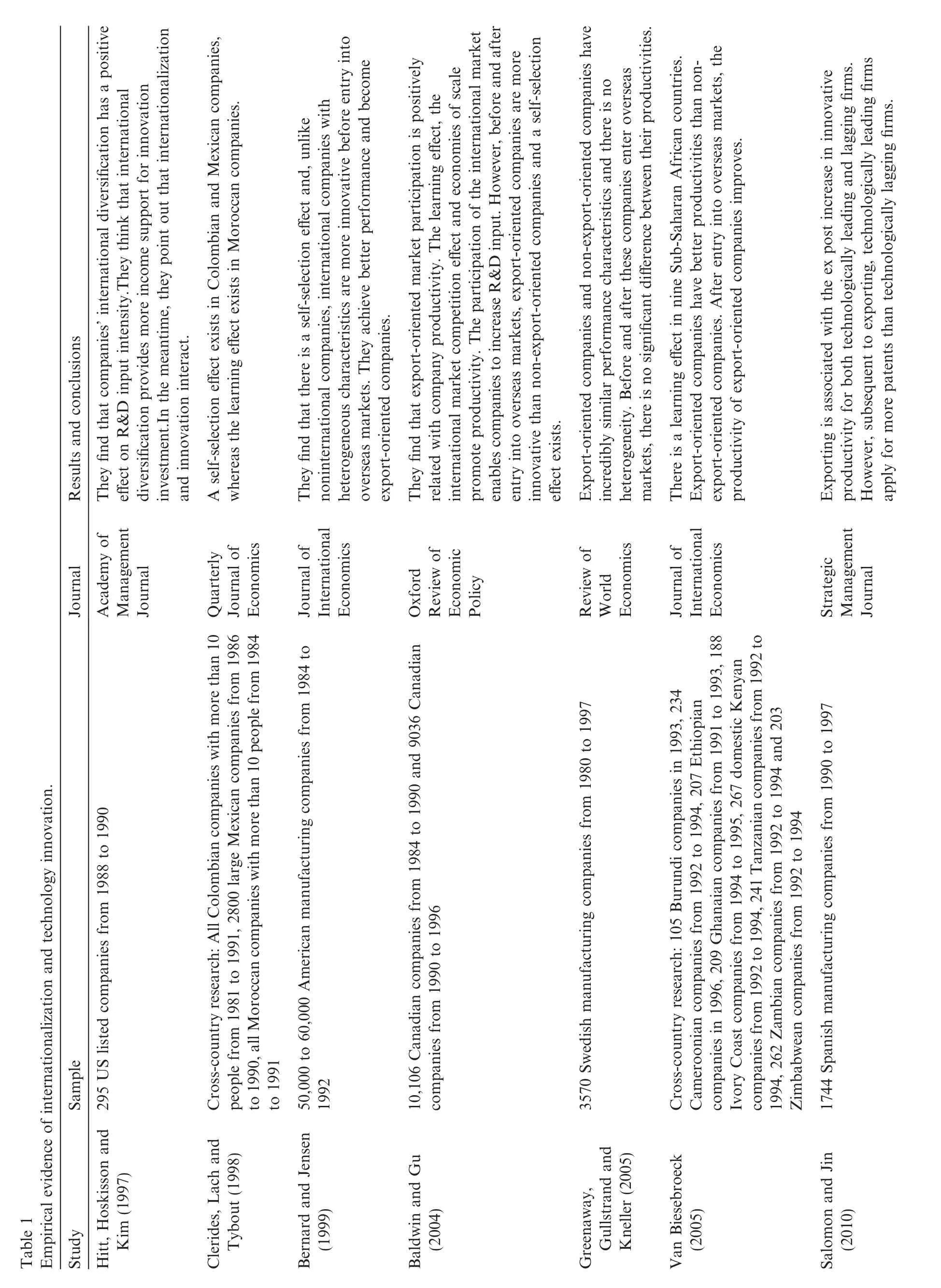


3.Research design
3.1.Sample selection and data sources
We use Chinese ChiNext companies from 2009 to 2012 as research samples and financial data from the China Stock Market and Accounting Research(CSMAR)Database.Using the annual reports of listed companies,we hand collect the R&D data,overseas income structures and overseas institutions.The patent data of listed companies are from the China Patent Database published by China Intellectual Property Office Intellectual Property Press.We classify and arrange the patents owned by listed companies according to year.After excluding the missing data,we obtain a final sample of 825 firm-year observations.Of these observations,36,153,281 and 355 correspond to 2009,2010,2011 and 2012,respectively.
3.2.Model specifications and variable definitions
To test Hypothesis 1,we build the following regression models,Models(1)–(4),according to the relevant literature(Himmelberg and Petersen,1994;Hubbard,1998).The model variables are defined in Table 2.All of the behaviors related to cross-border expansion can be regarded as companies’internationalization;the sales,manufacturing or R&D in different areas or overseas markets embody internationalization(Hitt et al.,1994,1997).Therefore,according to the relevant literature(Hitt et al.,1997;Lu and Beamish,2004;Altomonte et al.,2013),we adopt overseas sales intensity(Overseas_Sales),the proportion of overseas revenue(Export_Rate)and overseas institutions(Overseas_Agency)to measure the degree of internationalization.Due to the different institutions in Hong Kong,Macao,Taiwan and mainland China,the sales revenues in these three areas are included in the overseas sales revenue.

To alleviate the impact of endogeneity,we build Models(5),(6)and(7)to further investigate the influence of companies’internationalization on R&D input according to Models(1),(2)and(3).The definitions of the main variables are presented in Table 2.

To better alleviate the impact of endogeneity,we also use the two-stage least squares(TSLS)method to test the influence of companies’internationalization on R&D.We follow the literature(Lileeva and Tref l er,2010;Bustos,2011;Bratti and Felice,2012)and choose the proportion of assets of foreign-funded firms in ChiNext companies with output values of over 5 million yuan(Foreign_ratio)as an instrumental variable for internationalization.The data are from the Industrial Statistics Data of the National Bureau of Statistics.The proportion of foreign assets in ChiNext companies with output values over 5 million yuan is a good indicator of the degree of internationalization.It also has no direct interaction with corporate independent innovation and is irrelevant to the regression residuals of Models(2),(3)and(4).That is,it meets the instrumental variables’exogeneity requirements.The TSLS regression process is as follows.During the first stage,Overseas_Sales,Export_Rate and Overseas_Agency are adopted to conduct the regression of Foreign_ratio and all control variables except for Overseas_Sales,Export_Rate and Overseas_Agency from Models(2),(3)and(4),including Domes_Sales(only in Overseas_Sales),Tobin’s Q,Lev,Ceo_Gender,Ceo_Age,Ceo_Education,Ceo_Experience,Dual,First_Stake,Property,VC,Size,Year and Industry.The following induction model is used:

where other exogenous variables include Domes_Sales(only in Overseas_Sales),Tobin’s Q,Lev,Ceo_Gender,Ceo_Age,Ceo_Education,Ceo_Experience,Dual,First_Stake,Property,VC,Size,Year and Industry.The fi tted values of Overseas_Sales,Export_Rate and Overseas_Agency are extracted using the preceding equation.During the second stage,the fi tted values of Overseas_Sales,Export_Rate and Overseas_Agency replace Overseas_Sales,Export_Rate and Overseas_Agency in Models(2),(3)and(4)to conduct the regression analysis.To test Hypothesis 2,we construct the Poisson regression in Models(9),(10)and(11)according to related studies(Pakes and Griliches,1980;Bound et al.,1984;Hausman et al.,1984).The variables are defined in Table 2.Patent output has strong lagged e ff ects and results from current and lagged R&D expenditures.We control the lagged one period and lagged two period of companies’R&D inputs(RD_intensityt-1and RD_intensityt-2The authors are grateful for the referees’suggestions.).

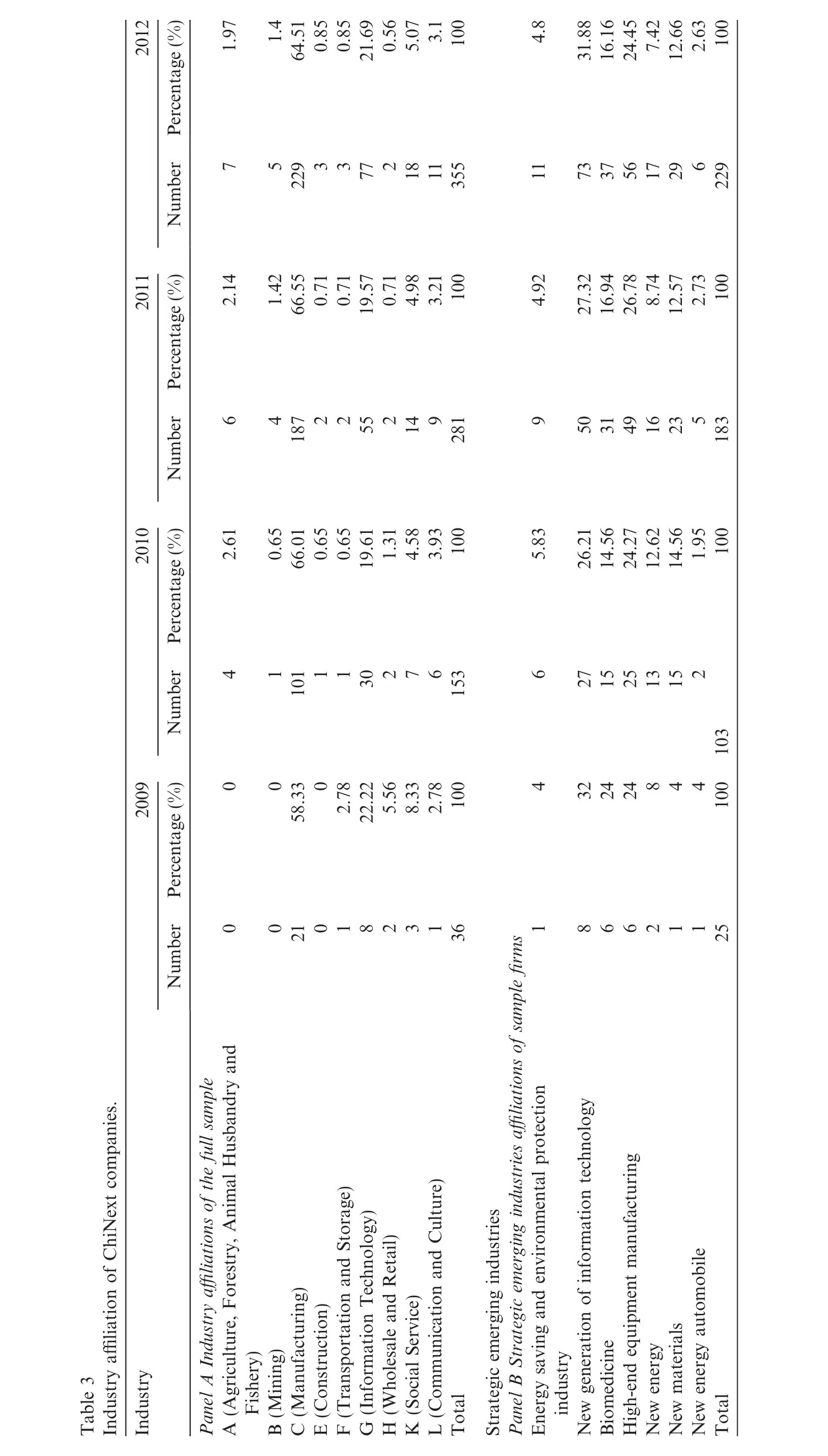

Table 4 Overseas income of ChiNext companies.
The empirical literature indicates that dependent variables(RD_intensity and△Patents)and independent variables(Overseas_Sales,Export_Rate and Overseas_Agency)may be influenced by company characteristics(Bernard and Jensen,1999;Melitz,2003;Greenaway et al.,2005)and manager characteristics2The authors are grateful for the referees’suggestions.(Faleye,2011;Debrulle and Maes,2015;Naldi et al.,2015;Sala and Yalcin,2015).For example,venture companies or adventurous managers tend to choose the internationalization strategy.These kinds of companies or managers are more inclined to invest in innovative high-risk projects.Therefore,we select firm size(Size),firm investment opportunities(Tobin’s Q),financial risk(Lev),CEO duality(Dual),proportion of the largest shareholder(First_Stake),nature of the controlling owner(Property),venture capital(VC),firm life cycle(Age),CEO gender(Ceo_Gender),CEO age(Ceo_Age),educational background of CEO(Ceo_Education)and overseas experience of CEO(Ceo_Experience)as our control variables.
4.Empirical results
4.1.Descriptive statistics
Table 3 shows the industry affiliations of ChiNext companies.Panel A shows 229 and 77 companies in the manufacturing and information technology industries,respectively.Panel B presents the sample by strategic emerging industries,with 73 companies in new generation of information technology and 56 companies in high-end equipment manufacturing.The number of companies in energy saving and environmental protection and new energy automotive is relatively small.
Table 4 presents the descriptive statistics of overseas income for ChiNext companies.Of the 355 ChiNext companies,81(22.82%)are non-exporters that never export,190(53.52%)are exporters that always export,80 are entrants(22.82%)that begin exporting and 1 is a quitter that no longer exports.This shows that the degree of internationalization of ChiNext companies is higher and that most companies actively explore the international market to earn overseas income.
Table 5 presents the descriptive statistics of export region distribution for ChiNext companies.It shows that ChiNext companies have expanded their businesses in five continents,with a considerable number of companies selling their products and services to Europe,North America and South America.From the dynamic trend,the export region of ChiNext companies is mainly in Asia(excluding Hong Kong,Macao and Taiwan)and Hong Kong,and Macao and Taiwan.Asia is the area with the largest overseas export of ChiNext companies in China.In 2012,182 companies exported their products to Asia(excluding Hong Kong,Macao and Taiwan)and 62 companies exported their products to Hong Kong,and Macao and Taiwan.Moreover,under the guidance of the ‘‘going out” strategy,ChiNext companies have actively explored markets in Europe and North America.The companies that export to Europe and North America have maintained increasing trends.
Table 6 presents the descriptive statistics for the sample of ChiNext companies.The mean value of RD_intensityt,RD_intensityt-1and RD_intensityt-2of the sample companies are 2.32%,2.23%and 2.36%,respectively,which are higher than 2%,the basic survival line recognized by the OECD.This indicates that under the guidance of the national strategy for building an innovative nation,great value has been attached to independent innovation by Chinese enterprises.Investment in technological innovation has also greatly increased.

Table 5 Export region distribution of ChiNext companies.
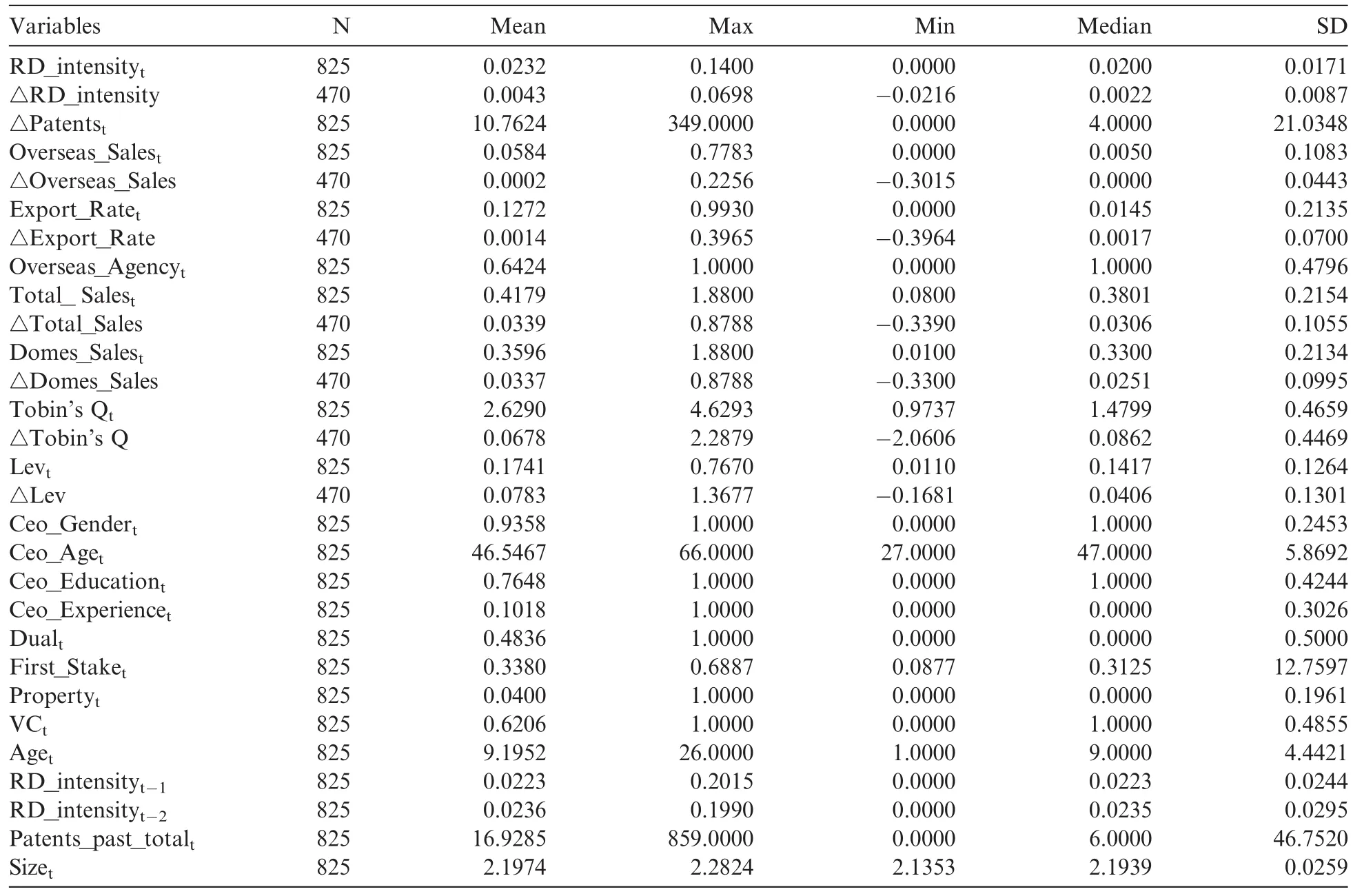
Table 6 Descriptive statistics.
This phenomenon reflects the clear positioning of the ChiNext market,which is committed to supporting the growth and strength of high-tech and high-growth enterprises.The mean value of△RD_intensity is 0.43%,representing the increase in momentum of R&D in ChiNext companies.The mean value of△Patent is 10.7624,which shows that ChiNext companies have strong capabilities for innovation.However,new patents are distributed unevenly with a great standard deviation of 21.0348,which reflects significant differences in the innovation capabilities of the sample companies.
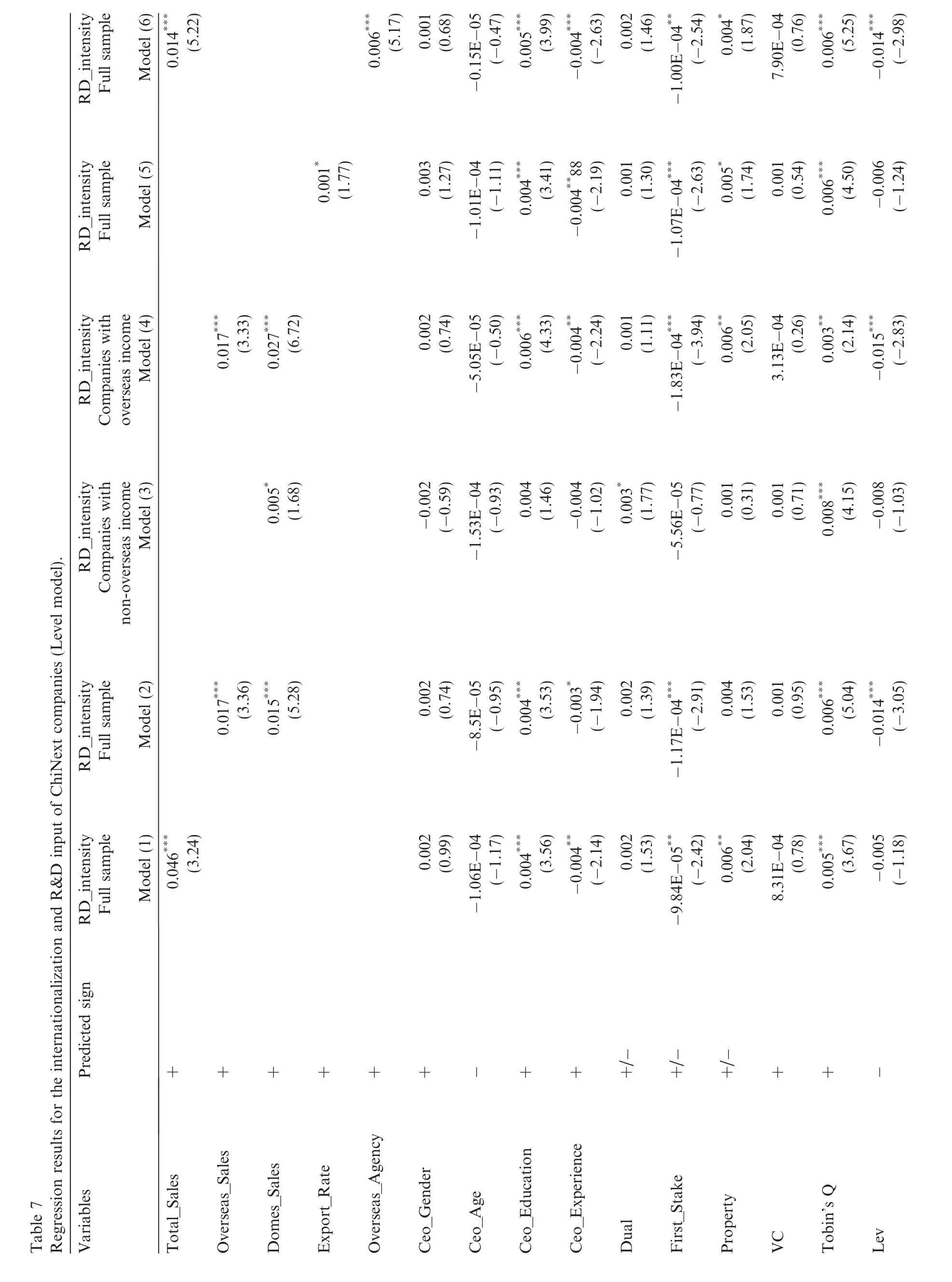
In terms of internationalization,the mean value of Export_Rate is 12.72%,indicating that on average 12.72%of ChiNext companies’incomes come from overseas markets.The means of△Export_Rate and△Overseas_Sales are 0.14%and 0.02%,respectively,showing the increase in momentum of the proportion of overseas incomes of ChiNext companies.In addition,the mean value of Overseas_Agency is 0.6424,which suggests that 64.24%of the companies have set up branches abroad.
As for the control variables,the mean value of Ceo_Gender is 0.9358,indicating that 93.58%of the sample companies have male CEOs.The mean value of Ceo_Education is 0.7648,implying that the vast majority of ChiNext companies’CEOs are highly educated.The mean and median of Ceo_Experience are 0.1018 and 0.0000,respectively,showing that CEOs with overseas experience are rarely seen in ChiNext companies.Only 10.18%of the sample companies have CEOs with overseas experience.Moreover,the mean and median of Lev are 0.1741 and 0.1417,respectively,meaning that the financial risks of ChiNext companies are generally low.The mean,median and standard deviation of First_Stake are 0.3380,0.3125 and 12.7597,respectively.Thus,large shareholders are commonly seen in ChiNext companies and the proportions of the largest shareholders vary drastically.The mean and median of Property are 0.0400 and 0.0000,respectively,denoting that the vast majority of ChiNext companies are non-state-owned companies.The mean of VC is 0.6206,which suggests that the vast majority of ChiNext companies are associated with the equity support of venture capital.
4.2.Multivariate regression analysis
Table 7 examines the impacts of the internationalization of ChiNext companies on R&D investments.According to the regression results,the F-statistics of all of the models are significant at the 1%level,indicating high-fitting precision.All of the values of adjusted R2are greater than 27%,signifying that the explanation is reliable.With all other related factors controlled,there is a significant positive relationship betweenTotal_Sales and RD_intensity in Model(1).The regression coefficient is 0.046,which is significant at the 1%level.This indicates that R&D intensity is stronger when the sales income of a company is higher.We conduct further tests in Model(2),dividing the sales revenues of companies into Overseas_Sales and Domes_Sales according to the source of sales revenue.A significant positive relationship is discovered between Overseas_-Sales,Domes_Sales and RD_intensity.The regression coefficients are 0.017 and 0.015,respectively,which are significant at the 1%level.This shows that more overseas and domestic incomes lead to stronger R&D intensity.Furthermore,overseas income,which measures a company’s degree of internationalization,contributes more to R&D investments than domestic income(0.017>0.015).The results demonstrate that an internationalization strategy has a significant incentive effect on R&D inputs.The entrepreneurial companies with higher degrees of internationalization have higher R&D inputs.

Table 9 Two-stage regression results for the internationalization and R&D input of ChiNext companies(Foreign_ratio).

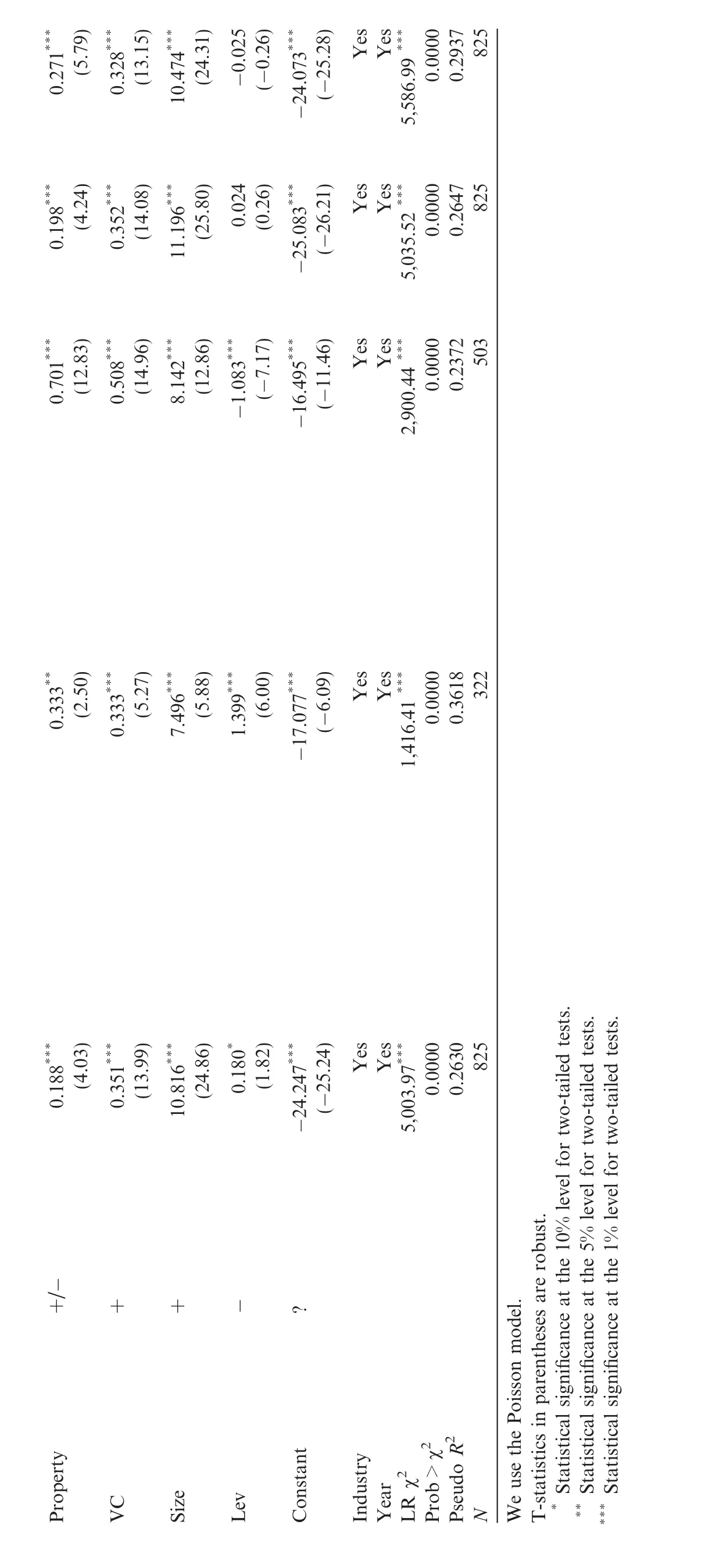
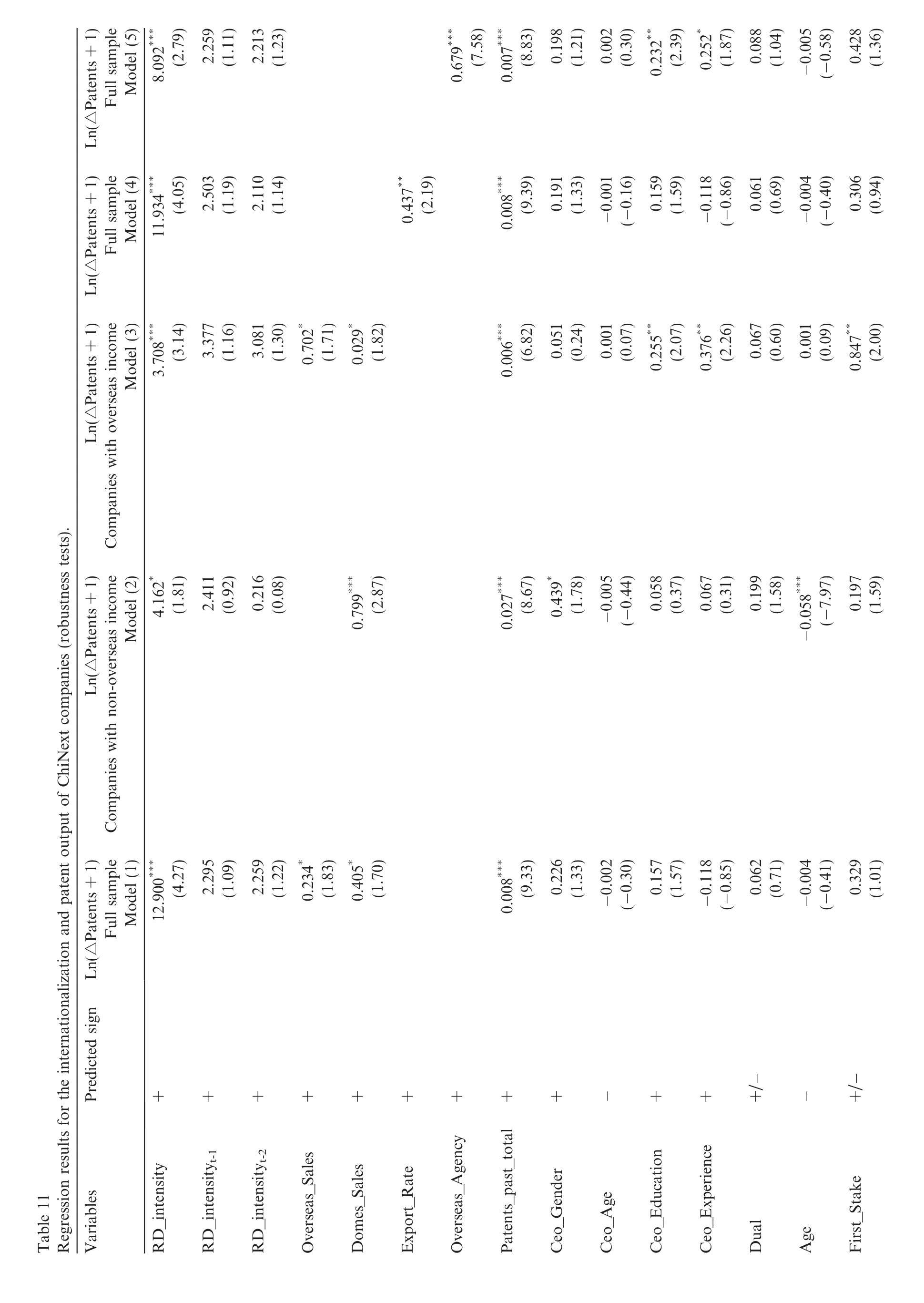
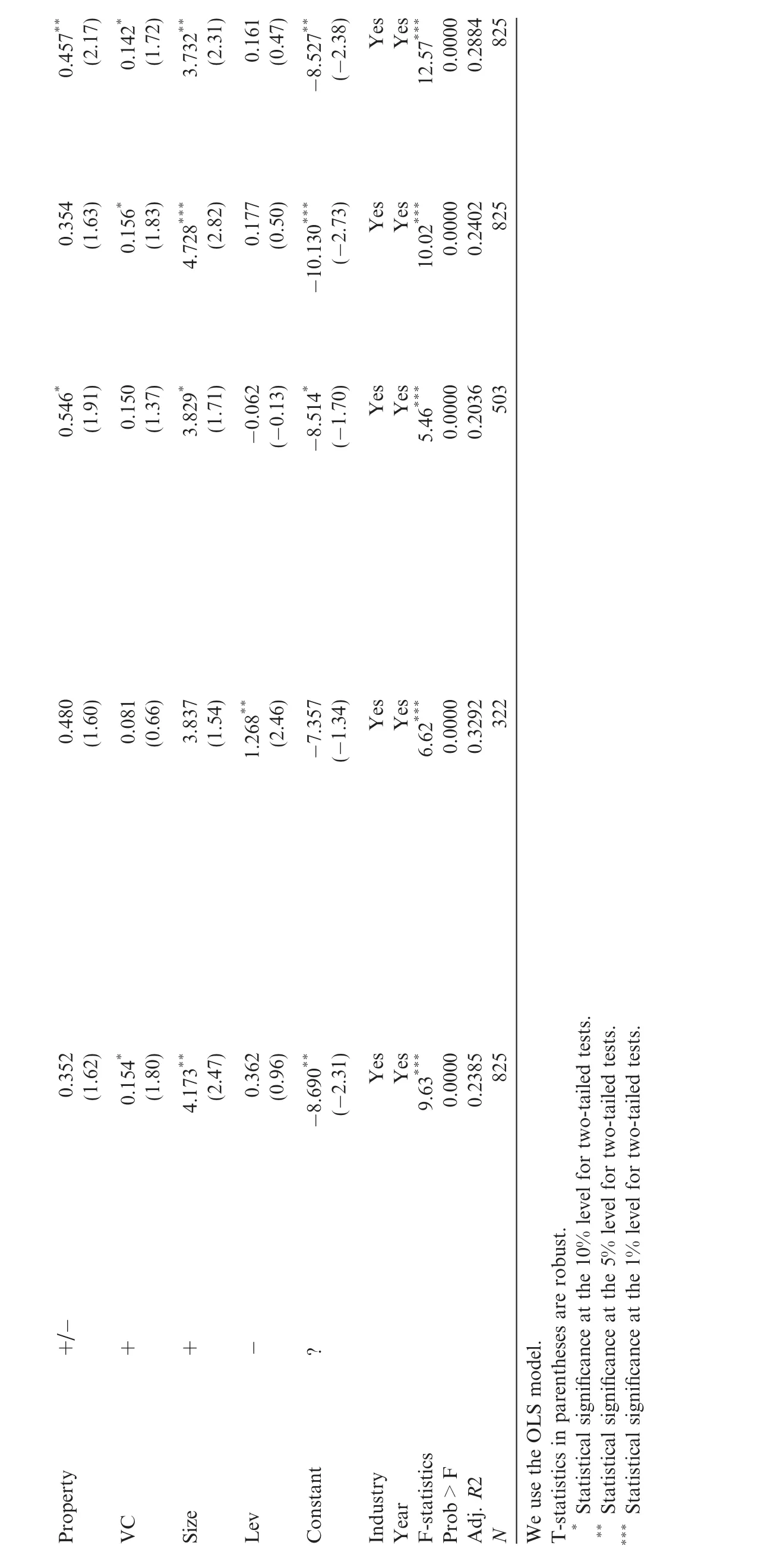

Table 12 Univariate analysis of the influence of internationalization on R&D input and patent output(exporters vs.non-exporters).
To obtain robust results,we conduct further tests grouped by the existence of overseas income.One group consists of ChiNext companies without internationalization,which means that all of their revenues are domestic.The other group is made up of ChiNext companies that have overseas revenues.The results are displayed in Models(3)and(4).Overseas_Sales is significantly positively related to RD_intensity in Model(4).The regression coefficient is 0.017,which is significant at the 1%level.Thus,an internationalization strategy has a significant incentive effect on R&D input.The entrepreneurial companies with higher degrees of internationalization have higher R&D inputs.
Using Export_Rate and Overseas_Agency as proxy variables of internationalization,further tests are conducted in Models(5)and(6).Export_Rate is significantly positively related to RD_intensity in Model(5).The regression coefficient is 0.001,which is significant at the 10%level.This illustrates that companies with higher degrees of internationalization have higher R&D inputs.Additionally,Overseas_Agency is significantly positively related to RD_intensity in Model(6).The regression coefficient is 0.006,which is significant at the 1%level.This implies that setting up branches overseas has a significant positive effect on domestic R&D.Overall,these results provide support for Hypothesis 1.An internationalization strategy has a significant incentive effect on R&D input.The entrepreneurial companies with higher degrees of internationalization have higher R&D inputs.
In terms of the control variables,Tobin’s Q is significantly positively related to RD_intensity.This shows that better investment opportunities increase R&D intensity investments.
To obtain more robust results,the Change model is used to further investigate the impacts of ChiNext companies’internationalization on R&D.The results are shown in Table 8.A significant positive relationship between△Total_Sales and△RD_intensity is shown in Model(1).The regression coefficient is 0.014,which is significant at the 1%level.This shows that changes in sales revenues cause changes in R&D investments in the same direction.△Overseas_Sales and△Domes_Sales are significantly positively related to△RD_intensity in Model(2).The regression coefficients are 0.022 and 0.013,respectively,which are significant at the 5%and 1%levels,respectively.This shows that greater changes in overseas and domestic income lead to greater changes in R&D intensity.Furthermore,overseas income,which measures a company’s degree of internationalization,contributes more to changes in R&D investments than domestic income(0.022>0.013).This supports the conclusion that an internationalization strategy has an incentive effect on R&D.Changes in the degree of internationalization beget changes in RD_intensity in the same direction.
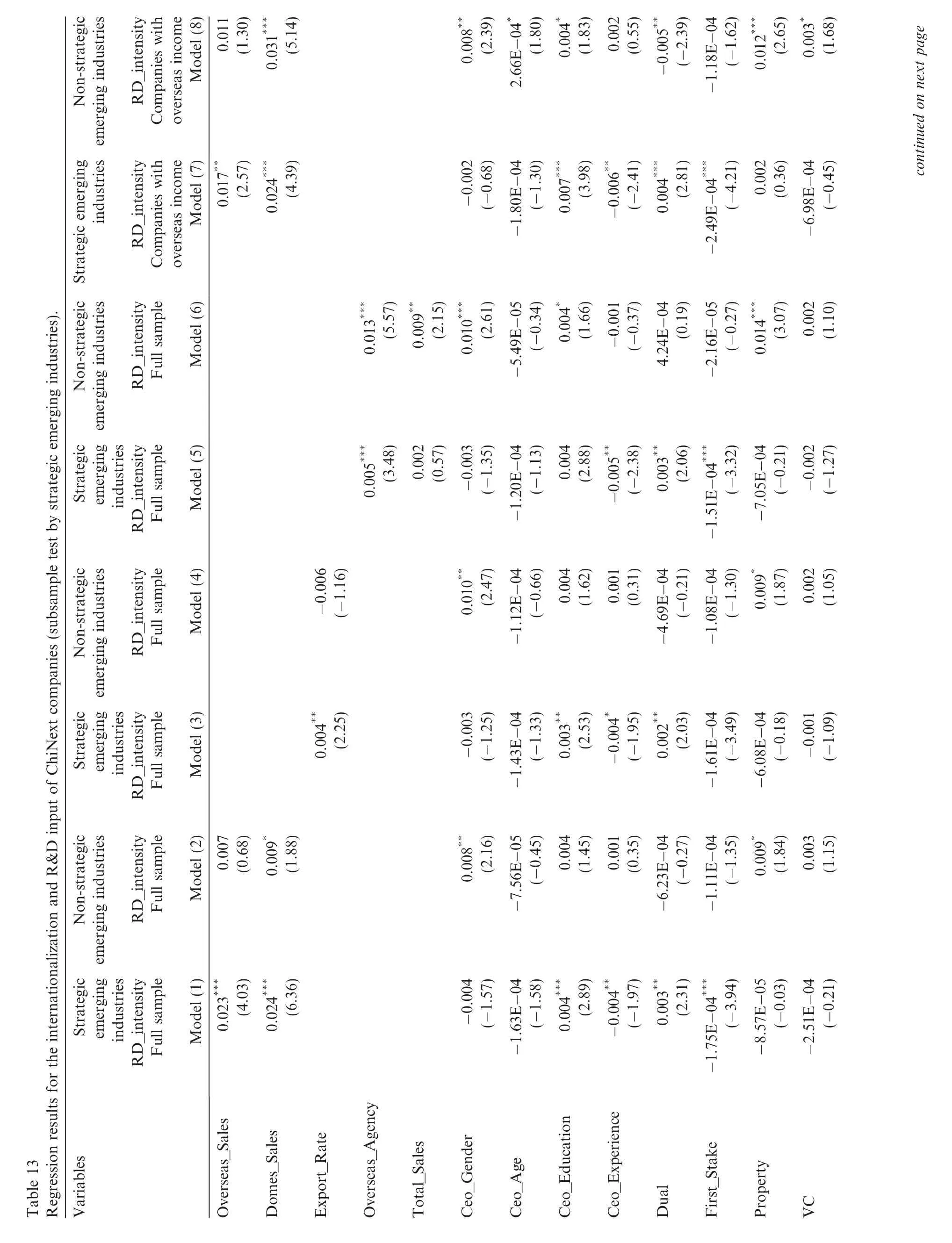






To make our test results more robust,we conduct further tests grouped by the existence of overseas income.One group consists of ChiNext companies without internationalization,which means that all of their revenues are domestic.The other group consists of ChiNext companies that have overseas revenues.The results are displayed in Models(3)and(4).△Overseas_Sales and△Domes_Sales are significantly positively related to△RD_intensity in Model(4).The regression coefficients are 0.023 and 0.013,respectively,which are significant at the 1%and 5%levels,respectively.Thus,an internationalization strategy has a significant incentive effect on R&D input for internationalized ChiNext companies.Overseas income,which measures a company’s degree of internationalization,contributes more to changes in R&D investments than domestic income(0.023>0.013).
△Export_Rate is significantly positively related to△RD_intensity in Model(5).The regression coefficient is 0.001,which is significant at the 10%level.This indicates that a higher△Export_Rate,which measures the degree of internationalization,strengthens RD_intensity.The empirical evidence reported in Table 8 thus supports Hypothesis 1.An internationalization strategy has an incentive effect on R&D.In addition,the control variables in the model are consistent with the previous regression results.
Based on previous studies(Lileeva and Trefler,2010;Bustos,2011;Bratti and Felice,2012),we use TSLS to test the effects of internationalization on independent innovation while considering the endogeneity of internationalization.The corresponding results are shown in Table 9.
As shown in Table 9,an internationalization strategy still has an incentive effect on R&D input after controlling for endogeneity.Companies with higher degrees of internationalization have higher R&D inputs.The empirical evidence reported in Table 9 provides additional support for Hypothesis 1.
To completely investigate the influence of an internationalization strategy on entrepreneurial companies’independent innovation,an empirical analysis of the influences of internationalization on the efficiency of patent output is displayed in the remaining part.In light of the related literature(Pakes and Griliches,1980;Hausman et al.,1984),we adopt the Poisson model to explore the relationship between internationalization,R&D input and patent output.The results are shown in Table 10.
According to Models(1)to(5)in Table 10,when other variables such as RD_intensityt-1and RD_intensityt-2are controlled,RD_intensity,Patents_past_total and△Patents are significantly positively related.The corresponding regression coefficients are significant at the 1%level.This shows that companies with higher R&D inputs and more knowledge stock have more patent outputs.
In Models(1),(3),(4)and(5),the proxy variables of internationalization strategy,such as Overseas_Sales,Export_Rate and Overseas_Agency,are significantly positively related to△Patents.The corresponding regression coefficients are 0.280,3.561,0.288 and 0.722,respectively,which are all significant at the 1%level.Thus,internationalization can significantly increase entrepreneurial companies’patent outputs.Moreover,Overseas_Sales has greater effects on patent output than Domes_Sales in Model(3)(3.561>0.331).Therefore,an internationalization strategy can improve the efficiency of patent output.The empirical evidence reported in Table 10 thus supports Hypothesis 2.
In Table 11,the ordinary least squares(OLS)model is adopted to replace the Poisson model for further robustness testing.Models(1),(3),(4)and(5)show that when other variables such as RD_intensityt-1and RD_intensityt-2are controlled,proxy variables of internationalization strategy such as Overseas_Sales,Export_Rate and Overseas_Agency are significantly positively related to△Patents.The corresponding regression coefficients are 0.234,0.702,0.437 and 0.679,respectively,which are significant.This shows that internationalization can significantly increase the number of entrepreneurial companies’patent outputs.In Model(3),Overseas_Sales has a greater effect on patent output(0.702>0.029)than Domes_Sales.This result is essentially the same as that in Table 10,further demonstrating that our results are robust.The internationalization strategies of companies have obvious efficiency improvement effects on patent output.The higher the degree of internationalization,the higher companies’patent outputs.This further supports Hypothesis 2.
(二)药物选用 目前,常用抗寄生虫药物有:氯硝柳胺、硝氯酚、左旋咪唑、敌百虫、丙硫咪唑、芬苯达唑、阿维菌素、伊维菌素、新型复合驱虫药(含伊维菌素、芬苯达唑、增效剂、稳定剂)等。
To make the results more robust,the differences between export and non-export companies in R&D inputs and patent outputs are compared.The results are shown in Table 12.
Table 12 shows that export companies have higher R&D intensities and more patent outputs than nonexport companies regardless of the mean and median.An internationalization strategy has an incentive effect on R&D and R&D output.Thus,Hypotheses 1 and 2 are supported.
5.influence of internationalization on strategic emerging industries:An expanding analysis
Decision of the State Council on Accelerating the Fostering and Development of Strategic Emerging Industries(2010,No.32),promulgated by the State Council in October 2010,determines the focus on the development of energy saving,new generation of IT and seven other strategic emerging industries,requiring the relevant departments to promptly formulate plans and implement specific supporting measures.Moreover,Guiding Opinions on Promoting the Internationalization of Strategic Emerging Industries(2011,No.310),jointly promulgated by the Ministry of Commerce,the National Development and Reform Committee and nine other ministries and commissions in September 2011,explicitly state that global innovation resources are to be used to enhance the ability of industrial innovation.To this end,the ChiNext market attaches more importance to the development of strategic emerging industries.We believe that the ChiNext market is perfect for researching the impacts of internationalization strategy on R&D in strategic emerging industries,as a large sum of high-quality companies in strategic emerging industries are listed in the ChiNext market.
Conforming with the Strategic Emerging Industry Classification(2012)(Trial)compiled by the National Statistics Bureau in December 2012,the samples are subdivided into strategic emerging industries to further explore the effects of internationalization strategy on R&D in strategic emerging industries.
More specifically,in correspondence with the main business and prime products disclosed in the prospectuses,540 observations defined in strategic emerging industries include 27 observations in the energy saving and environmental protection industry,158 observations in the new generation of IT industry,89 observations in the pharmaceutical industry,136 observations in the high-end equipment manufacturing industry,48 observations in the new energy industry,68 observations in the new materials industry and 14 observations in the new energy vehicles industry.Table 13 reports the results.
In Table 13,a comparison of Models(1)and(2)shows a significant positive relationship between Overseas_Sales and RD_intensity in strategic emerging industries.The regression coefficient is 0.023,which is significant at the 1%level.However,in non-strategic industries,there is no significant relationship between overseas sales and R&D input.This shows that the internationalization strategies in strategic emerging industries positively promote R&D.Companies with higher degrees of internationalization have higher R&D inputs.
A comparison of Models(3)and(4)shows that Export_Rate,which measures internationalization,is significantly positively related to RD_intensity.The regression coefficient is 0.004,which is significant at the 5%level.However,no significant relation is found between overseas sales and R&D input in non-strategic industries.This shows that the internationalization strategies in strategic emerging industries have incentive effects on R&D.Companies with higher proportions of overseas sales have higher R&D inputs.
In Models(5)and(6),Overseas_Agency has significant positive impacts on RD_intensity in either strategic or non-strategic industries.The regression coefficients are 0.005 and 0.013,respectively,which are significant at the 1%level.Thus,the establishment of overseas institutions positively promotes R&D for companies in both strategic and non-strategic industries.In addition,a comparison of Models(7)and(8)shows that the different natures of strategic emerging industries cause overseas sales to have different influences on RD_intensity from those of other internationalization companies.In strategic emerging industries,both the regression coefficients and significance levels are higher than those of non-strategic companies(coefficient 0.017>0.011,T value 2.57>1.3).This further shows that an internationalization strategy has more pronounced incentive effects on R&D inputs in strategic emerging industries.An internationalization strategy has a more positive role in promoting the R&D of companies in strategic emerging industries.
A comparison of Models(1)and(2)in Table 14 shows that△Overseas_Sales and△Domes_Sales are significantly positively related to△RD_intensity.The regression coefficients are 0.030 and 0.022,respectively,which are significant at the 1%level.In non-strategic industries,changes in overseas and domestic sales have no significant impacts on changes in R&D inputs.This shows that the internationalization strategy mainly exerts positive impacts on R&D in companies in strategic emerging industries.More changes in overseas and domestic sales cause greater changes in R&D input.In addition,compared with domestic revenues,changes in overseas revenues,which measure companies’internationalization,cause greater changes in R&D inputs(0.030>0.022).This further proves that in strategic emerging industries an internationalization strategy has an incentive effect on R&D input,and that changes in the degree of internationalization lead to changes in R&D input in the same direction.
In Models(3)and(4),the△Export_Rate of strategic industrial companies is positively related to the change in R&D input.The regression coefficient is 0.005,which is significant at the 5%level.In nonstrategic industrial companies,changes in the proportion of overseas sales have no significant impacts on R&D input.This shows that in strategic industrial companies,greater changes in the proportion of overseas sales,which measure the degree of internationalization,cause greater changes in R&D input.Therefore,implementing internationalization strategies in strategic industrial companies have an incentive effect on R&D.
Compared with Models(5)and(6),changes in overseas sales have significant effects on strategic industrial companies’R&D.The regression coefficient of△Overseas_Sales is 0.022,which is significant at the 5%level.No significant impact is found in non-strategic industries.In addition,comparing Models(5)and(7)shows that an internationalization strategy has a more significant influence on R&D input in strategic emerging industries than in non-strategic emerging industries.
To comprehensively study the impact of an internationalization strategy on the independent innovation of strategic emerging industries,we further examine the impact of internationalization on patent output in strategic emerging industries.The results are shown in Tables 15 and 16.
Models(1)to(6)in Table 15 show that after controlling other variables such as RD_intensityt-1and RD_intensityt-2,proxy variables of internationalization strategy such as Overseas_Sales,Export_rate and Overseas_Agency are significantly positively related to△Patents in both strategic emerging and nonstrategic industries.The regression coefficients are 0.756,0.182,0.506 and 0.212,0.521 and 1.062,respectively.This proves that internationalization can significantly improve entrepreneurial companies’patent outputs in both strategic and non-strategic emerging industries.
Comparing Models(1)and(4)shows that in strategic emerging industries,Overseas_Sales has a greater impact on patent output than domestic sales(0.756>0.260).In non-strategic industrial companies,Dome_S-ales has a greater impact than Overseas_Sales on patent output(0.571>0.212).The results of Model(7)show that in strategic industrial companies,Overseas_Sales has a greater impact than Domes_Sales on patent output(1.037>0.101).The results illustrate that in strategic emerging industries,companies with higher degrees of internationalization have higher patent outputs.Thus,an internationalization strategy can enhance companies’patent outputs in strategic emerging industries.
In Table 16,the OLS model substitutes the Poisson model for further robustness testing.The regression results are substantially the same as those in Table 15,which further demonstrates that our results are robust.In summary,an internationalization strategy has more pronounced effects on the independent innovation input and efficiency of strategic emerging industries.
6.Conclusions and implications
Guided by the ‘‘going-out” strategy,Chinese enterprises have accelerated their pace of internationalization in recent years.We study how an internationalization strategy affects the independent innovation of Chinese entrepreneurial companies from two dimensions:R&D input and patent output.The main findings are outlined as follows.
First,a large number of ChiNext companies have implemented internationalization strategies and have actively expanded into overseas markets to earn foreign revenues.
Second,an internationalization strategy has a significant incentive effect on R&D input.Companies with higher degrees of internationalization have higher R&D inputs.After controlling for endogeneity,the incentive effect still exists.
Third,an internationalization strategy has significantly improved the efficiency of patent outputs.Companies with higher degrees of internationalization have higher patent output efficiencies.
Fourth,an internationalization strategy has more pronounced effects on independent innovation in strategic emerging industries.
Improving independent innovation capability and building a long-term competitive advantage are not only vital to the survival and development of China’s companies,but also important to China’s long-term economic development.An internationalization strategy is conducive to enhancing Chinese companies’independent innovation,regardless of R&D input or patent output.Therefore,Chinese entrepreneurial companies should clearly understand that an internationalization strategy is an important way to enhance independent innovation capacity.They must adhere to the going-out strategy,actively expand overseas markets,integrate global resources through various approaches such as exports and overseas investment and establish foreign institutions to enhance their independent innovation capacities.However,aside from encouraging and guiding companies to open up to the world,the government should vigorously promote the internationalization of strategic emerging industries to achieve industrial transformation and improvement.
From the two dimensions of R&D input and patent output,we provide empirical evidence that Chinese entrepreneurial companies’internationalization strategies influence their independent innovation.This study has two limitations.First,the ChiNext companies’sales data are not reported clearly or completely with respect to detail or regional division,making it difficult to confirm overseas sales in certain regions.Thus,we fail to study the influences of internationalization on innovation under the distribution of export regions.Second,the sample period used covers 2009 to 2012.Future studies should choose longer sample periods.
Acknowledgments
The authors thank Charles Chen,Oliver Rui,the anonymous referees and the editor for their constructive suggestions,and the CJAR symposium participants at Hunan University for their helpful comments.Any errors are the sole responsibility of the authors.This study is supported by the National Natural Science Foundation of China(Project No.71402189)and the Fundamental Research Funds for the Central Universities of the Chinese Ministry of Education(Project No.2014116).
Altomonte,C.,Aquilante,T.,Be´ke´s,G.,Ottaviano,G.I.P.,2013.Internationalization and innovation of firms:evidence and policy.Econ.Policy 28(76),663–700.
Baldwin,J.,Gu,W.,2004.Trade liberalization:export market participation,productivity growth and innovation.Oxford Rev.Econ.Policy 20(3),372–392.
Barney,J.B.,1991.Firm resource and sustained competitive advantage.J.Manage.17,99–120.
Bernard,A.B.,Jensen,J.B.,1999.Exceptional exporter performance:cause,effect,or both?J.Int.Econ.47(1),1–26.
Bernard,A.B.,Jensen,J.B.,Schott,P.K.,2006.Trade costs,firms and productivity.J.Monet.Econ.53,917–937.
Bilkey,W.J.,Tesar,G.,1977.The export behavior of smaller sized Wisconsin manufacturing firms.J.Int.Bus.Stud.8,93–98.
Bound,J.,Cummins,C.,Griliches,Z.,1984.Who Does R&D and Who Patents,in R&D,Patents and Productivity.University of Chicago Press,Chicago,IL.
Bratti,M.,Felice,G.,2012.Are exporters more likely to introduce product innovations?The World Economy 35(11),1559–1598.
Bustos,P.,2011.Trade liberalization,exports and technology upgrading:evidence on the impact of MERCOSUR on Argentinean firms.Am.Econ.Rev.101(1),304340.
Cassiman,B.,Golovko,E.,2011.Innovation and internationalization through exports.J.Int.Bus.Stud.42(1),56–75.
Cheng,J.L.C.,Bolon,D.S.,1993.The management of multinational R&D,a neglected topic in international business research.J.Int.Bus.Stud.24,1–18.
Clerides,S.,Lach,S.,Tybout,J.,1998.Is learning by exporting important?Micro-dynamic evidence from Colombia,Mexico and Morocco.Quart.J.Econ.113(1),903–948.
Debrulle,J.,Maes,J.,2015.Start-ups’internationalization:the impact of business owners’management experience,start-up experience and professional network on export intensity.Euro.Manage.Rev.12,171–187.
Faleye,O.,2011.CEO directors,executive incentives,and corporate strategic initiatives.J.Financ.Res.34(2),241–277.
Fisch,J.H.,2003.Optimal dispersion of R&D activities in multinational corporations with a genetic algorithm.Res.Policy 32,1381–1396.
Granstrand,O.,Hikanson,L.,Sjiilander,S.,1993.Internationalization of R&D:a survey of some recent research.Res.Policy 22,413–430.
Greenaway,D.,Gullstrand,J.,Kneller,R.,2005.Exporting may not always boost firm productivity.Rev.World Econ.141(4),561–582.
Griliches,Z.,1990.Patents statistics as economic indicators:a survey.J.Econ.Lit.28(4),1661–1707.
Grossman,G.M.,Helpman,E.,1991.Trade,knowledge spillover,and growth.Euro.Econ.Rev.35,517–526.
Hausman,J.,Hall,B.,Griliches,Z.,1984.Econometric models for count data with an application to patent R&D relationship.Econometrica 7,909–938.
Helpman,E.,Melitz,M.,Yeaple,S.,2004.Export versus FDI with heterogeneous firms.Am.Econ.Rev.94(1),300–316.
Himmelberg,C.P.,Petersen,B.C.,1994.R&D and internal finance:a panel study of small firms in high-tech industries.Rev.Econ.Stat.76,38–51.
Hitt,M.A.,Hoskisson,R.E.,Ireland,H.,1994.A midrange theory of the interactive effects of international and product diversification on innovation and performance.J.Manage.20,297–326.
Hitt,M.A.,Hoskisson,R.E.,Kim,H.,1997.International diversification:effects on innovation and firm performance in productdiversified firms.Acad.Manag.J.40(4),767–798.
Hoskisson,R.O.,Johnson,R.A.,1992.Corporate restructuring and strategic change:the effect on diversification strategy and R&D intensity.Strateg.Manag.J.13,625–634.
Hubbard,R.G.,1998.Capital market imperfections and investment.J.Econ.Lit.36(1),193–225.
Kafouros,M.I.,Buckley,P.J.,Sharp,J.A.,Wang,C.Q.,2008.The role of internationalization in explaining innovation performance.Technovation 28(1–2),63–74.
Kobrin,S.,1991.An empirical analysis of the determinants of global integration.Strateg.Manag.J.12,17–31.
Kotabe,M.,Srinivasan,S.S.,Aulakh,P.S.,2002.Multinationality and firm performance:the moderating role of R&D and marketing capabilities.J.Int.Bus.Stud.33,79–97.
Kotabe,M.,1990.The relationship between of f shore sourcing and innovativeness of U.S.multinational firms:an empirical investigation.J.Int.Bus.Stud.21(4),623–638.
Lileeva,A.,Tref l er,D.,2010.Improved access to foreign markets raises plant-level productivityEllipsisfor some plants.Quart.J.Econ.125(3),1051–1099.
Lo´pez,J.,Garcı´a,R.M.,2005.Technology and export behavior:a resource-based view approach.Int.Bus.Rev.14,539–557.
Love,J.H.,Ganotakis,P.,2013.Learning by exporting:lessons from high-technology SMEs.Int.Bus.Rev.22,1–17.
Lu,J.W.,Beamish,P.W.,2004.International diversification and firm performance:the S-curve hypothesis.Acad.Manag.J.47(4),598–609.
Melitz,M.,2003.The impact of trade in intra-industry reallocations and aggregate industry productivity.Econometrica 71(6),1695–1725.
Miller,D.J.,2004.Firm’s technological resources and the performance effects of diversification:a longitudinal study.Strateg.Manag.J.25,1097–1119.
Naldi,L.,Acbtenbagen,L.,Davidsson,P.,2015.International corporate entrepreneurship among SMEs:a test of Stevenson’s notion of entrepreneurial management.J.Small Bus.Manage.53(3),780–800.
Pakes,A.,Griliches,Z.,1980.Patents and R&D at the firm level:a first look.Econ.Lett.5,377–381.
Porter,M.E.,1985.Competitive Advantage.Free Press,New York.
Prashantham,S.,2005.Toward a knowledge-based conceptualization of internationalization.J.Int.Entrepren.3,37–52.
Qian,X.F.,Wang,J.R.,Huang,Y.H.,Wang,S.,2011.Exports and the productivity of Chinese industrial enterprises:self-selection effect or learning by exporting effect?J.Quant.Techn.Econ.2,37–51(in Chinese).
Roper,S.,Love,J.H.,2002.Innovation and export performance:evidence from U.K.and German manufacturing plants.Res.Policy 31,1087–1102.
Sala,D.,Yalcin,E.,2015.Export experience of managers and the internationalization of firms.World Econ.38(7),1064–1089.
Salomon,R.,Jin,B.,2010.Do leading or lagging firms learn more from exporting?Strateg.Manag.J.31,1088–1113.
Sanna-Randaccio,F.,Veugelers,R.,2007.Multinational knowledge spillovers with decentralised R&D:a game-theoretic approach.J.Int.Bus.Stud.38,47–63.
Santos,J.,Doz,Y.,Williamson,P.,2004.Is your innovation process global?Sloan Manage.Rev.45(4),31–37.
Schumpeter,J.A.,1942.Capitalism,Socialism and Democracy.Unwin,London.
Teece,D.J.,1986.Profiting from technological innovation:implications for integration,collaboration,licensing and public policy.Res.Policy 15(6),285–305.
Van Biesebroeck,J.,2005.Exporting raises productivity in Sub-Saharan African manufacturing plants.J.Int.Econ.67,373–391.
Von Zedtwitz,M.,Gassmann,O.,2002.Market versus technology drive in R&D internationalization:four different patterns of managing research and development.Res.Policy 31,569–588.
Zhang,J.,Li,Y.,Liu,Z.B.,2008.Exporting and productivity of Chinese firms:empirical study based on manufacturing firms of Jiangsu Province.Manage.World 12,11–26(in Chinese).
Zhang,J.,Li,Y.,Liu,Z.B.,2009.Does exporting boost productivity of Chinese firms.Manage.World 12,11–26(in Chinese).
7 September 2015 Accepted 22 May 2017 Available online 17 July 2017
*Corresponding author.
E-mail addresses:xuxinfeiji@126.com(X.Xu),xiayungigicolagi@163.com(Y.Xia),Chtl@znufe.edu.cn(C.Li).
http://dx.doi.org/10.1016/j.cjar.2017.05.001
1755-3091/Ⓒ2017 Sun Yat-sen University.Production and hosting by Elsevier B.V.
This is an open access article under the CC BY-NC-ND license(http://creativecommons.org/licenses/by-nc-nd/4.0/).
JEL Classifications:O32 F23
